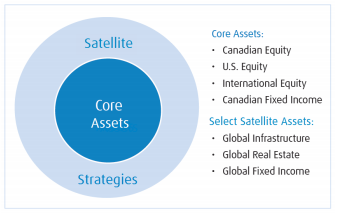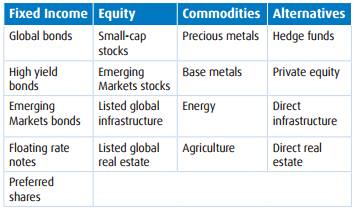Asset Allocation and How You Can Benefit From A Core-Satellite Investment Approach
Scot McLeod - Jul 12, 2017
Asset allocation is one of the most critical investment decisions an investor can make. Studies, such as the influential Brinson, Hood and Beebower paper, “Determinants of Portfolio Performance,1” suggest that the long-term strategic asset allocation of a portfolio accounts for over 90% of its return. According to the study, the portfolio’s strategic – or target – asset allocation will have a greater impact on its performance than will security selection or any short-term active or tactical asset allocation shifts.
The first step when constructing a portfolio is to determine the appropriate asset allocation, based on an investor’s risk profile and investment objectives, and then select investments across each asset class. There are several approaches to constructing an investment portfolio. One such strategy is to adopt a core-satellite approach. Core-satellite investing involves using a core portfolio to anchor the portfolio’s strategic asset allocation, and adding satellite investments to enhance returns and/or mitigate risk.
Fundamentals of a core-satellite portfolio
A typical investment portfolio is comprised of traditional asset classes that represent the broad market, and generally include investment-grade fixed income securities and large-cap Canadian, U.S. and international equities. These asset classes make up the portfolio’s “core” investments. Specific securities within each asset class will depend on the investor’s return objectives and risk tolerance.In order to further diversify the portfolio, non-traditional asset classes – referred to as “satellite” strategies – are used to enhance returns and manage risk. Satellite strategies often have greater return potential than core asset classes, but may be considered higher risk (with greater volatility) when held on their own. However, they often have a lower correlation – a measure of the degree to which two investments move in relation to each other – to traditional assets classes. Satellite strategies can include asset classes or themes that can be used as either short-term, tactical investments, or held for longer periods of time. Combining investments with a low correlation can improve the risk/return characteristics of a portfolio.

Examples of satellite strategies are shown in Table 1. By using one, or more, of these satellite strategies in tandem with a core portfolio, investors can further diversify their portfolio across additional asset classes, regions, sectors, market capitalizations, currencies and/or investment styles. For example, real assets such as commodities, infrastructure and real estate have a tangible value which can rise during periods of inflation. Infrastructure and real estate can also offer a steady and predictable cash flow. Global fixed income securities provide Canadian investors with exposure to bonds in countries with different currencies and interest rate cycles, which can help reduce interest rate risk. While hedge funds, such as market neutral or multi-strategy funds, can actually lower volatility and improve a portfolio’s risk-adjusted performance.
Table 1: Non-Traditional or “Satellite” Strategies

Constructing a core-satellite portfolio
A core-satellite portfolio can be implemented by using: - Active strategies that seek to add value through security selection such as, separately managed account mandates or mutual funds;
- Passive strategies that seek to track the performance of an index representing a particular investment market, such as exchange-traded funds (ETFs); or
- A combination of active and passive strategies.
One approach to constructing a core-satellite portfolio is to use passive investments for efficient markets and active investments for less efficient markets. Many traditional asset classes, such as the U.S. equity market, are considered to be very efficient, making it difficult for active managers to outperform. Non-traditional asset classes, such as Emerging Markets equities or high yield bonds, are often considered less efficient. Many of these asset classes may be more difficult to access, can be less liquid, and are not covered as broadly by research analysts, which can enable active managers greater potential to add value.
The most critical step
Determining the appropriate asset allocation is the most important step when building your portfolio. Whether you use a passive strategy, an active strategy, or a combination of both, the addition of one, or more, satellite strategies to a core portfolio can potentially enhance returns, reduce risk and provide a better return/risk profile for your portfolio.Click here to download the article
1 Gary P. Brinson, L. Randolph Hood, and Gilbert L. Beebower, “Determinants of Portfolio Performance,” Financial Analysts Journal, July/August 1986.